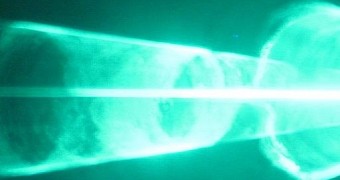The Bat-signal has been an iconic element of comic book lore ever since it was first used in “Batman” to call the caped crusader for a chat with Gotham City's commissioner Gordon. Now, though, we may finally see the day when it's not just a fictional plot device.
Mist is a natural means of capturing, refracting and decomposing light, which is why it is considered for holographic technology.
This also means that, if there's enough of it in one place, it can play the part of a canvas as well, where one can project messages.
Since clouds are basically very condensed, thick layers of mist in the sky, a strong enough skylight can actually produce images on their underside.
Unfortunately, this doesn't help much when there aren't clouds in the sky, which is most of the time in many areas of the world, especially in temperate and arid climates. Now, though, the Japanese have made it possible.
Laser-based figures projected into thin air
A Japanese company called Burton Inc. has revealed a technology that can form three-dimensional images without any sort of canvas or screen behind.
Fluttering butterflies, rotating spirals and even the outline of an apple were projected into the space one meter above the van loaded with the system.
The holographic projections were made by emitting hundreds of bursts of light per second and keeping the beam in motion.
Intense laser light was basically focalized into a very tiny spot in the air, causing the molecules there to emit white light that looks like an exploding LED.
One may say that the people at Burton Inc. have cracked the mystery of causing points of light to appear wherever they want in the air. From here, they could conceivably refine their technology until they can produce true holograms, even if they don't come out in color.
The possible uses of the new “Bat-signal” system
Disaster alerts are one thing. If the system is reborn at a larger scale, it could project large alerts in case of tsunamis, approaching storms, inbound earthquakes, etc. Quite useful for those who aren't near a radio or TV when the alarm is sounded.
Unfortunately, at the moment, the images cannot be very large, and they can't reach higher than 16.5 feet / 5 meters above the device. So you can clearly see that the Burton Inc. folks still have a long way to go, even if this really is the best holographic tech example ever.

 14 DAY TRIAL //
14 DAY TRIAL //